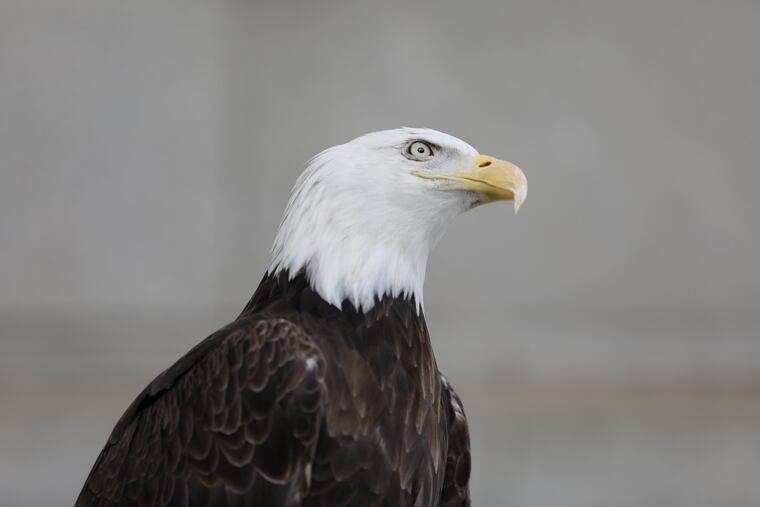Tackling a top killer of New Jersey’s bald eagles: electrocution
The bald eagle has made a magnificent comeback in New Jersey, but one thing remains its biggest killer year in and year out: electrocution.

A female bald eagle took flight in September 2014 from the Maurice River in Cumberland County, soaring westward thousands of feet over the Delaware Bay. Nicknamed Millville after her hometown, she made her way to the upper Chesapeake Bay, 50 miles away, according to GPS tracking.
Two months later, she was found dead at a Delaware farm, where she was electrocuted while stopping to perch on a power line. She was less than a year old.
Since then, 34 bald eagles have met similar fates, according to data compiled in annual reports by the New Jersey Bald Eagle Project, a partnership overseen by the New Jersey Division of Fish and Wildlife, and Conserve Wildlife Foundation.
Between 2015 and 2019, electrocution was the top cause of death of raptors found injured or killed. Other documented causes of death included crashes with vehicles (29) and eagle-on-eagle fights (14). An additional 29 bald eagles died from unknown causes, and some deaths are never documented.
Overall, the bald eagle population in New Jersey has made a remarkable comeback, from nearly none in 1970 to 211 territorial pairs today that claim the state as their territory. Yet mortality rates are high, especially in the young. The raptors contend with violent storms, West Nile virus (birds of prey can acquire the virus from eating infected birds), man-made snares, and even poisoning from ingesting lead shot in carrion killed by hunters.
Electrocution remains a growing concern because as the eagle population has swelled, the birds have begun nesting in urban and suburban areas where chances of encountering power lines are much higher.
“We just picked up an electrocuted bird on Sunday, a four-year-old eagle that was found right under a power line near Pickle Factory Pond in Belleplain State Forest,” said Kathleen Clark, supervising zoologist for the state’s Division of Fish and Wildlife. “We’ve known that that’s an eagle area for a long time.”
Clark explained that eagles are vulnerable to electrocution because of their large wingspan, which can reach six or seven feet. If a talon touches an energized line and a wing touches another energized line or ground source, electricity flows through the bird, usually causing instant death.
“In general, electrocution is difficult to treat because the extent of the damage is not always immediately apparent,” said Lisa Smith, executive director of Tri-State Bird Rescue & Research, Inc. in Delaware.
Each case is different, Smith said, and staff has to weigh whether treatment is possible. Of six eagles thought to have been electrocuted that the center has received over the last two years, three were dead on arrival and three were “humanely euthanized.”
Raptor experts, state wildlife officials, and utility companies have been working together for more than a decade to help stem the losses by electrocution.
It’s not large transmission lines and poles that pose the biggest problem, because wires tend to be spread out more, making them less dangerous. Rather, the eagles encounter the most danger on smaller distribution lines they like to perch on for hunting and other reasons.
Realistically, utility companies can’t bury all distribution lines. So they install protective equipment on existing ones, or build-in protections on new lines, said Cristina Frank, a biologist and raptor specialist who manages avian protection for Atlantic City Electric.
“The program, over the years, has really expanded in many different ways,” Frank said. “We have a lot of tools that we’ve developed.”
Atlantic City Electric serves the area of New Jersey with the highest concentration of bald eagles since its territory includes rural areas along the Delaware Bay, which provides miles of prime hunting ground for the birds.
Utility providers can use crossarms — wood mounted on a utility pole — on existing lines to spread wires farther apart. They can insulate conductors, or cover energized or grounded equipment. Some install barriers to prevent birds from perching. They also mark the lines, for instance, with colored tape or reflectors, so birds don’t fly into them.
Frank said the company has mapped its distribution lines and overlaid GPS tracking generated from bands on the birds to see which equipment is located near bald eagle habitats. Through that, Atlantic City Electric 2018 identified nearly 80 new eagle roosts within its service area and found 21 line segments with potential risk of collision. In some cases, the company has rebuilt lines to be more bird friendly.
“We do know that the bald eagle populations are increasing,” Frank said, “so we have ramped up our efforts.”
Likewise, Claudia Rocca, a project manager for the utility provider PSE&G, said her company also retrofits equipment to increase safety for the eagles.
For example, “on distribution poles that are frequented by eagles, we have added pole-top extensions where the eagles can safely perch away from the lines, as eagles tend to perch on the highest points,” Rocca said.
PSE&G also worked with the New Jersey Department of Environmental Protection to track 14 eaglets hatched from nests on its transmission towers.
It’s impossible to say how many deaths have been prevented through the programs. But Clark, the state zoologist, believes they are working.
“I think it’s certainly successful,” Clark said. “To do nothing would be to leave all these known risks out there on the landscape.”